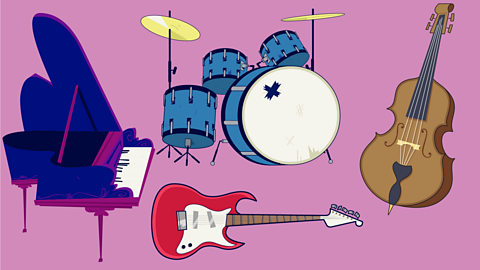What is a melody?

One of the best ways to express ourselves musically is by using melodyDifferent pitched notes played one after another making a tune..
Melodies can make us feel different things. A good melody is memorable and makes us want to sing along!
Jamaican reggae legend Bob Marley, wrote some of the most catchy and well known melodies.
Watch: Lightning Jelly explore melody with Bob Marley
Boy 1: Sorry I'm late, I had this weird dream about cannons and loud bangs!
Girl 1: Awesome!
Boy 1: It was scary! BUT I think I came up with the lyrics for our song. We're gonna go out with a bang bang, boom boom… Well?
Girl 2: It's… different.
Girl 1: You know, those lyrics could work. We just need something to make them catchy.
Girl 3: Why don't we just sing them and see what happens?
Girl 1: Ok, everybody!
The Band: BANG BANG BOOM BOOM! BANG BANG BOOM BOOM! BANG BANG BOOM BOOM!
Bob Marley: Yo man, take it easy!
Boy 2: Bob Marley! Cool!
Bob Marley: NOT cool, man. Your lyrics need…hmm, let me think what it need…?
A sweet, sweet tune. A MELODY!
They're the same thing you know, man.
Let me show you what I'm talking about…
Boy 2: Whoah! Let's get this melody started!
Bob Marley: Hold your horses, man!
First we got to learn about a little thing called pitch.
That's a nice low pitch, man.
And that's a high pitch.
You can put different pitches together to make a melody.
Why don't you try stir it up?
Girl 1: We’re gonna go out with a bang bang boom boom, yes we are, we really are, we're totally going out with a bang bang boom…
Bob Marley: Mmm, it's good, but it's a little bit long, man.
Boy 1: It's a bang bang, boom boom. Boom boom, boom boom.
Girl 2: Bang bang, boom boooom.
Bob Marley: Okay, okay, don't worry.
Here's a few tips from old Bob to make your melody sweet.
Melodies have a nice shape and don't stay on the same note.
Like this…
Don't worry, about a thing. Cos every little thing, is gonna be alright.
Ya see, the melody is nice and short, easy to sing.
The pitches don't jump around like a frog, man.
Boy 2: Oh, the pitches are close together!
Bob Marley: Now try it on your lyrics!
Boy 2: We're gonna go out with a…
Boy 1 …bang bang…
Girl 1: …boom boom?
Boy 2: That's…actually good!
Bob Marley: Now we're jamming!
The Band: We're gonna go out with a bang bang, boom boom!
Bob Marley: Don't worry, every little thing's gonna be alright.
How can we make melodies?

Melodies are composed using two things:
- pitchHow high or low a musical sound is.
- rhythmA pattern of sounds of different durations.
We have lots of notes to choose from. We can use an instrument or our voice.
First, let's play a game to remind us of the difference between high and low pitched sounds.
Join in with this pitch game and see if you are pitch perfect!

Watch: What is pitch?
Katie: Clogs has introduced us to pitch Mr Brown and I am keen to learn more.
Mr Brown: Great! Let's get hands on and make some noise. Now what do you notice about these two chime bars?
Katie: Err… one of them is longer than the other.
Mr Brown: That's right! The longer chime bar is a low C. Have a listen.
Plays low C chime bar
Katie: Aww I like that sound.
Mr Brown: Now listen again but this time I'm going to sing the musical notes at the same time.
Plays chime bar I am a low C.
Katie: Nice voice Mr Brown. I am a low C. What do you think?
Mr Brown: Very nice Katie. The other, shorter, chime bar is a high G.
- Plays chime bar*
Katie: Oh yeah, that has a much higher pitch.
Mr Brown: And now with our voices, let's sing together in the correct pitch.
Plays chime bar
Mr Brown and Katie: I am a high G.
Katie: Great vocals we've got going there Mr Brown, just let me know when you want to join forces to become a global singing sensation like me.
Mr Brown: Yeah sure, Katie. I think it is time to see if you are pitch perfect with a listening game.
Katie: Oo, I love a game.
Mr Brown: You are going to need to close your eyes for this one. The rules are simple. If I play the lower pitched chime bar, the low C, you have to sit down and touch the floor with your hands. If I play the higher pitched chime bar, the high G, you have to put your hands in the air.
Katie: Bring it on! I'm all ears and join in anyway you can. You can raise your arms when you hear the high note and sit down or touch the floor when you hear the low note. Are you ready?
Mr Brown: You've got until the buzzer sounds. Here we go.
Plays chime bars
Buzzer
Katie: Oh that was harder than I thought Mr Brown. I had to really listen carefully.
Mr Brown: I'm impressed. Great work Katie. Now I think you're ready for lesson two.
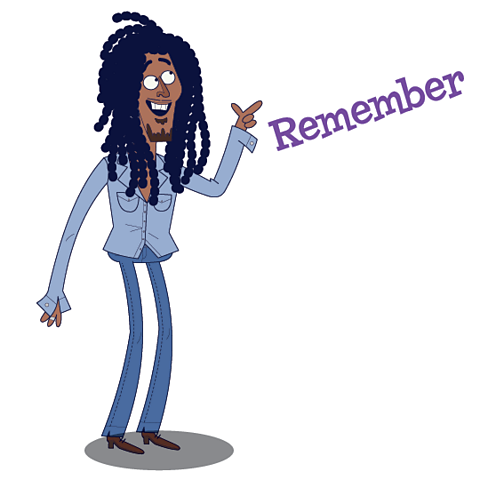
To create our own melody we now need to put a rhythm with the different pitched sounds (notes).
Remember, a rhythm is a pattern of short and long sounds.
Let's compose a melody
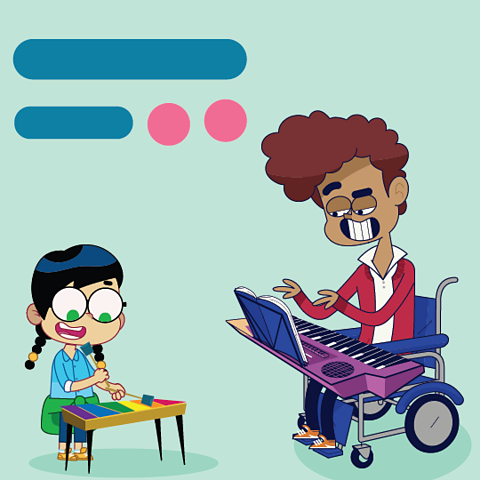
First, we need a rhythm.
- Try creating a pulseA steady, regular beat that continues throughout the song. by marching on the spot or clapping your hands.
- Now sing a sentence over the top. You can sing anything but if you're stuck, you could trying using your favourite foods as a starting point. For example: "Chicken and chips and mushy peas!"
- Now change the pitch of each word as you sing. You can go up then down, or down then up. Try something that is fun and easy to remember.
Congratulations, you have composed a melody!
Try this with a friend - one of you can keep the pulse while the other is singing the rhythm.

Performing your melody
Now you've got your rhythm try singing or playing it with one sound. Then add another sound and another and another.
Experiment to hear what sounds good and improviseCreating or playing music on the spot without a musical score. to see if anything jumps out that sounds good to you.
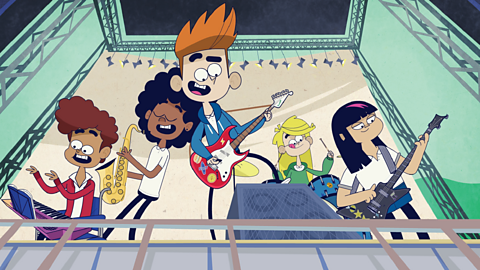
Now you've got some ideas, you just have to develop the parts you like.
You can try repeating sounds or adding and taking sounds away. You can take one section of your melody and move all the sounds up and down a pitch.
Try putting your melodies in an order one after the other. This can turn your individual melodies into a tune or a whole piece of music - exciting!
Watch: How do melodies make us feel different emotions?
You can always start composing by thinking of what emotion you want your audience to feel. Melodies have the power to make us feel different emotions.
There's no right or wrong way to compose a melody. Give it a go and see what you come up with!
Clogs: We are looking a melodies. Melodies are made up of different pitches and rhythms played one after another to make a tune.
Naomi: So does it matter which pitches and which rhythms you choose?
Clogs: Yes, this will decide how someone will feel listening to the melody. For example, how does this make you feel?
Melody plays
Naomi: Aww that makes me feel happy.
Clogs: Mmmm. Okay, now what about this one?
Naomi: Aww that one makes me feel sad.
Clogs: Yes quite. I have saved the best for last. Okay?
Plays melody
Doesn't this one just make you want to party?
Naomi: Yes, it definitely does but I should really go and check in with Mrs Thomas. Maybe she'll know what this letter is all about.
Let's explore some examples.
You might take a melody you've made and stretch it out so the sounds are longer and slower. Add different pitches and you might have a sad tune.
Listen to this example:
You can speed up your melodies too. Play or sing them in a short and spiky kind of way. This might make it sound more exciting or happy.
Have a listen to this example:
Activities
Quiz
SATs preparation resources. activitySATs preparation resources
Get ready for the SATs papers with videos, activities, quizzes and games to refresh your knowledge and practise your skills.

More on Creating Music
Find out more by working through a topic
- count11 of 12
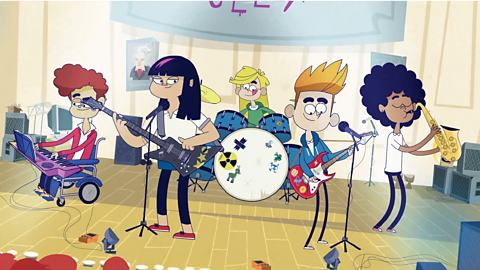
- count12 of 12
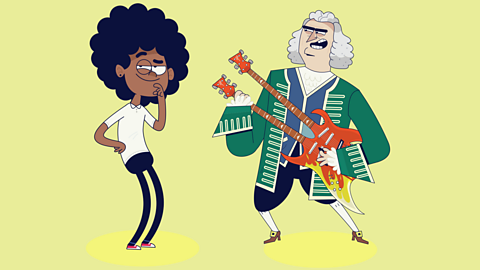
- count1 of 12
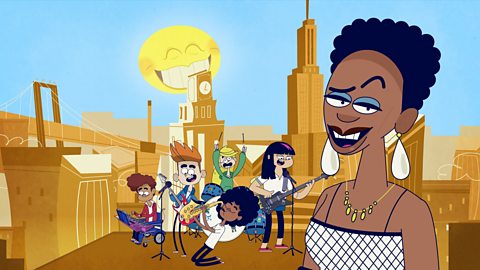
- count2 of 12
